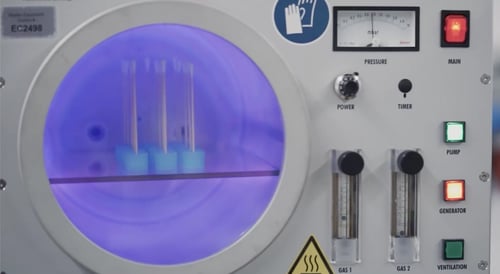Plasma technology is used to change the surfaces of many different materials. It is more environmentally friendly compared to wet cleaning and etching due to less waste disposal. The following is a list of various uses of plasma technology:
- Remove organic and inorganic contaminants
- Increase wettability and adhesion
- Increase bond strength
- Remove residue
One example of using plasma technology, specifically plasma etching, is gluing plastics. Plastics are normally difficult to lacquer or glue. However, with plasma etching, the surface area of the plastic can be increased and its microstructure changes, resulting in a better bonding between the plastic and the adhesive.
The medical, manufacturing, and electronic industries benefit from plasma etching to make reliable and durable products. A plasma etching process is essential in medical industries because medical equipment like catheters and filters need to be safe and sterile. Manufacturing companies want clean and oxide-free surfaces on the metals prior to gluing or bonding. In the electronics industry, printed circuit boards often need to be plasma etched prior to soldering.
Plasma Etching Mechanisms
Plasma etching is separated into four mechanisms. One mechanism is sputtering. Sputtering occurs when positive ions are accelerated across the plasma sheath and hit the substrate material. Some material is removed as a result due to the kinetic energy that was transferred onto the surface atoms which are removed from the surface. This mechanism differs from the other three plasma etching mechanisms because the interaction is only mechanical. Some disadvantages of sputtering are the lack of selectivity and slow etching rates. Selectivity is the reactive species’ capability to remove solely the material that is supposed to be removed and to avoid removing the masking material (along with the substrate material underneath). The masking material’s purpose is to prevent plasma etching in that area.
Another method of plasma etching is chemical. The only purpose of the plasma is to provide gaseous etchant species. Ions do not hit the substrate material in this mechanism. Active species in the gas phase react with substrate material in order to form a volatile product. Because of the fact that undesired side reactions will be less likely to happen under certain conditions (by changing the temperature or amount of reactants for example), chemical etching is more selective than the other three mechanisms.
Ion-enhanced energetic and ion-enhanced inhibitor mechanisms involve encounters of both neutral species and ions on the surface. The combination of neutral species and ions can cause more substrate material to be removed than the chemical or sputtering mechanisms separately. In ion-enhanced energetic mechanisms, neutral species have negligible or no affect until ions increase the reactivity of the substrate material with the neutral species.
The plasma (from the plasma etching system) provides etchants for chemical etching, ions for anisotropic etching, and inhibitor precursor molecules that adsorb or deposit on the substrate material and form an inhibitor layer. This inhibitor layer can stop etching reactions from occurring. In the ion-enhanced inhibitor mechanism, the ions that hit the surface prevent an inhibitor layer from forming and remove the barrier layer, which means the surface is exposed to plasma etchants for plasma etching.

